It looks like you're using an Ad Blocker.
Please white-list or disable AboveTopSecret.com in your ad-blocking tool.
Thank you.
Some features of ATS will be disabled while you continue to use an ad-blocker.
share:
I learned more from your thread than my visit in 2003 with a guided tour. Awesome awesome awesome!
Oh and thanks
Oh and thanks
Amazing thread.
There's alot i don't know about ancient sites as i've never had the chance to visit one so when threads like these come up i'm over the moon
Well written & presented,the pics are really good as well.
one of the reasons i stick around ATS
S+F
There's alot i don't know about ancient sites as i've never had the chance to visit one so when threads like these come up i'm over the moon
Well written & presented,the pics are really good as well.
one of the reasons i stick around ATS
S+F
reply to post by mcx1942
I Don't know why people call these things pyramids. They're closer to ziggurats.
I Don't know why people call these things pyramids. They're closer to ziggurats.
Hieroglyphic Writings and Stelae
The Maya themselves did not invent writing, but they did develop the most complex mixed-scripture writing system, made up of 800 glyphs. The origins of Maya writing may be traced back to the south of Mexico, to a place called Veracruz, as well as to Guatemala’s and El Salvador’s Pacific Coast. The people who lived there, the Olmecs or Mihezoke people, painted these first glyphs at Tres Zapotes on the year 29 BC, this was the first evidence of written language in ancient America.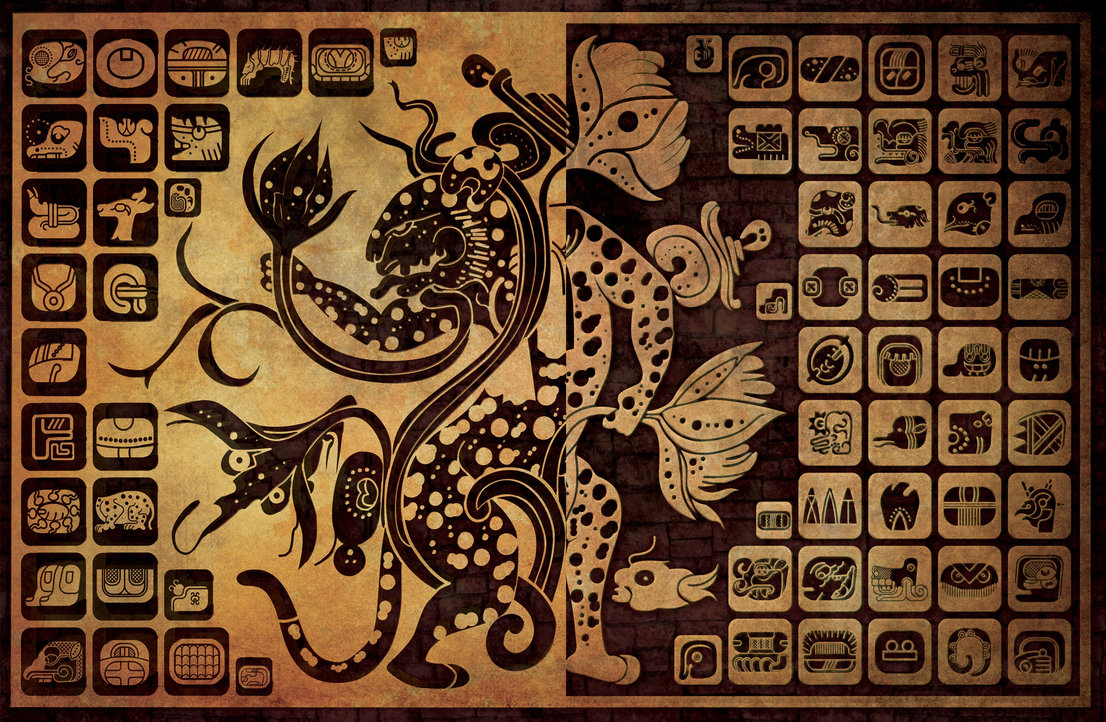 picture of glyph wall from Pelanque for visual
example
picture of glyph wall from Pelanque for visual
example
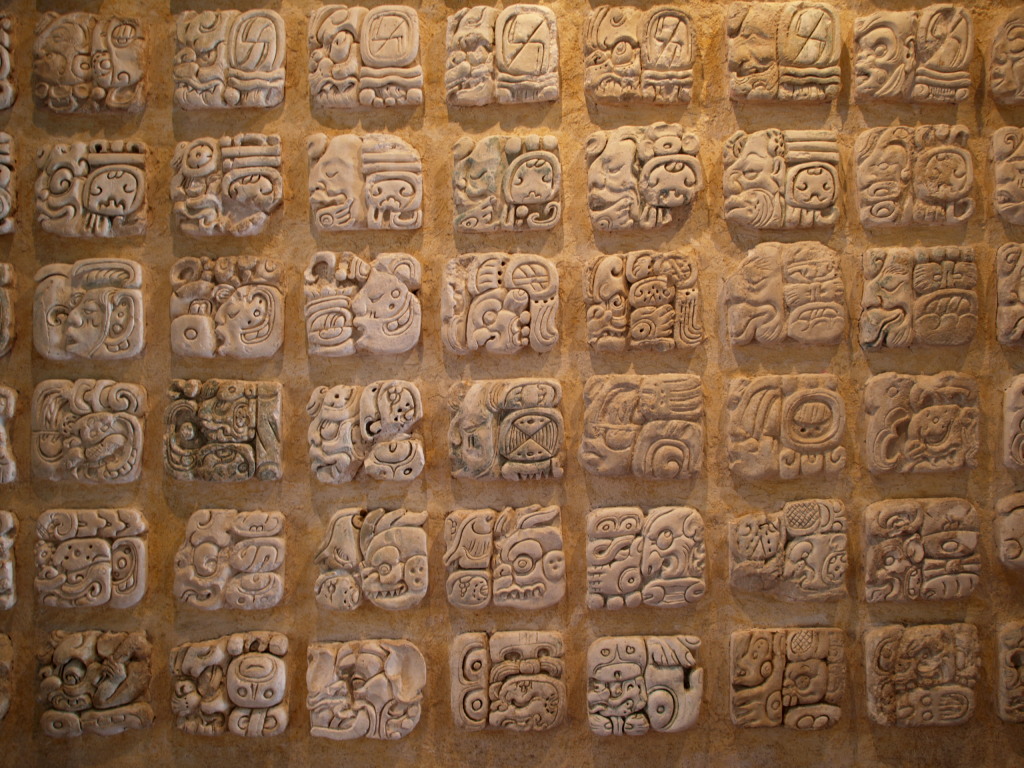 The written and spoken language really is its whole own thread so what I am going to do, is talk about the Stelae from Tikal.
Each in their own, beautiful works of sculpture.
The written and spoken language really is its whole own thread so what I am going to do, is talk about the Stelae from Tikal.
Each in their own, beautiful works of sculpture.
I find it fascinating that cultures divided by time and distance created similar stelae. Possible Lost Civilization connection? Maybe but for now I will just go into information on the Tikal stelae.
On Stela 29 the texts were written in blocks of the same size, each containing one or more signs. Within a glyph block there is usually one sign that is larger than the others: it is the “main sign”. Attached to it, will be affixes, super fixes, prefixes, postfixes, sub fixes and even infixes, which modify or define the main sign. Maya texts, beautifully painted or sculpted, express complete sentences with nouns, verbs, adjectives, adverbs, prepositions, conjunctions and more parts of language composition.
Stela 29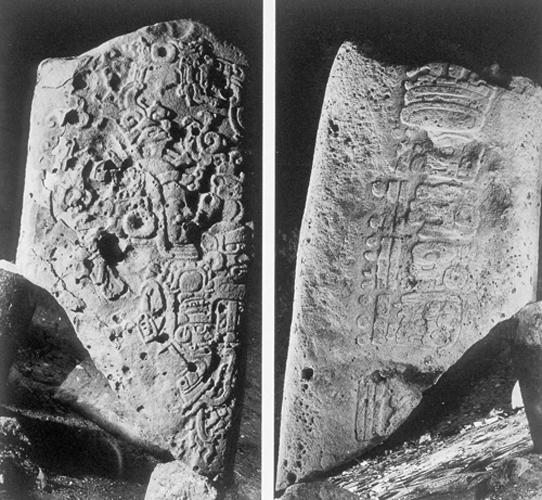
The Maya themselves did not invent writing, but they did develop the most complex mixed-scripture writing system, made up of 800 glyphs. The origins of Maya writing may be traced back to the south of Mexico, to a place called Veracruz, as well as to Guatemala’s and El Salvador’s Pacific Coast. The people who lived there, the Olmecs or Mihezoke people, painted these first glyphs at Tres Zapotes on the year 29 BC, this was the first evidence of written language in ancient America.
source
Mayan writing consisted of a relatively elaborate set of glyphs, which were laboriously painted on ceramics, walls or bark-paper codices, carved in wood or stone, or molded in stucco. Carved and molded glyphs were painted, but the paint has rarely survived. About 90% of Mayan writing can now be read with varying degrees of certainty, enough to give a comprehensive idea of its structure.
The Mayan script was a logosyllabic system. Individual symbols ("glyphs") could represent either a word (actually a morpheme) or a syllable; indeed, the same glyph could often be used for both. For example, the calendaric glyph MANIK’ was also used to represent the syllable chi. (It is customary to write logographic readings in all capitals and phonetic readings in italics.) It is possible, but not certain, that these conflicting readings arose as the script was adapted to new languages, as also happened with Japanese kanji and with Assyro-Babylonian and Hittite cuneiform. There was ambiguity in the other direction as well: Different glyphs could be read the same way. For example, half a dozen apparently unrelated glyphs were used to write the very common third person pronoun u-.


The most ancient text that presents the total set of characteristic traits of Maya writing is preserved in Stela 29 of Tikal, dated 292 AD. Glyphic texts documented the lives of Rulers: their births, accessions to the throne, marriages, wars, burials and other important facts about a Ruler’s story.Hieroglyphic writing is composed of signs for ideographs, which are units of meaning, words, or parts of compound words; and of syllables, which are units of sound.
A stele (pron.: /ˈstiːliː/, historically /ˈstiːl/; Greek: στήλη stēlē; plural: στήλαι stēlai), also stela (plural stelae /ˈstiːlaɪ/) Latin, is a stone or wooden slab, generally taller than it is wide, erected for funerals or commemorative purposes, most usually decorated with the names and titles of the deceased or living — inscribed, carved in relief (bas-relief, sunken-relief, high-relief, and so forth), or painted onto the slab. It can also be used as a territorial marker to delineate land ownership.
source
Stelae were also used to publish laws and decrees, to record a ruler's exploits and honors, to mark sacred territories or mortgaged properties, as territorial markers, as the boundary stelae of Akhenaton at Amarna, or to commemorate military victories. They were widely used in the Ancient Near East, Mesopotamia, Greece, Egypt, Eritrea, Ethiopia, and, most likely independently, in China and elsewhere in the Far East, and, more surely independently, by Mesoamerican civilisations, notably the Olmec and Maya
I find it fascinating that cultures divided by time and distance created similar stelae. Possible Lost Civilization connection? Maybe but for now I will just go into information on the Tikal stelae.
On Stela 29 the texts were written in blocks of the same size, each containing one or more signs. Within a glyph block there is usually one sign that is larger than the others: it is the “main sign”. Attached to it, will be affixes, super fixes, prefixes, postfixes, sub fixes and even infixes, which modify or define the main sign. Maya texts, beautifully painted or sculpted, express complete sentences with nouns, verbs, adjectives, adverbs, prepositions, conjunctions and more parts of language composition.
Stela 29

source
Stela 29 bears a Long Count (8.12.14.8.15) date equivalent to AD 292, the earliest surviving Long Count date from the Maya lowlands. The stela is also the earliest monument to bear the Tikal emblem glyph. It bears a sculpture of the king facing to the right, holding the head of an underworld jaguar god, one of the patron deities of the city. The stela was deliberately smashed during the 6th century or some time later, the upper portion was dragged away and dumped in a rubbish tip close to Temple III, to be uncovered by archaeologists in 1959
edit on 1/6/2013 by mcx1942 because: fix
edit on 1/6/2013 by
mcx1942 because: fix
Stela 29 continued. There are many stelae, these are some notable ones.
Many thought the characters depicted on the stelae were Gods. But as Maya Archaeology continued to make its pioneering advances in the middle of the humid rainforests of Guatemala, the contrary was revealed: the stelae contained nothing but information on the Rulers of The Maya World for more than 570 years.
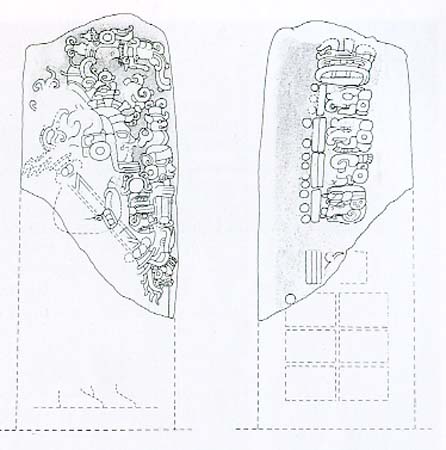
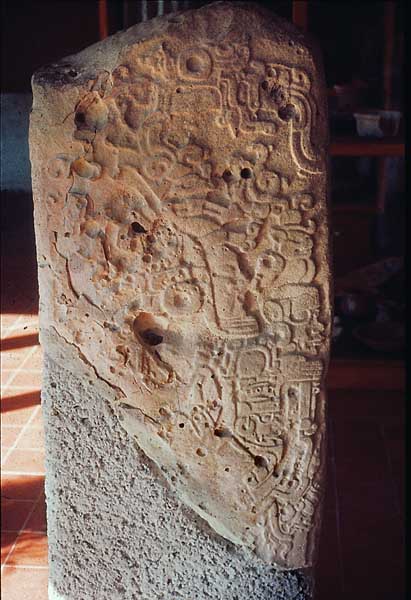
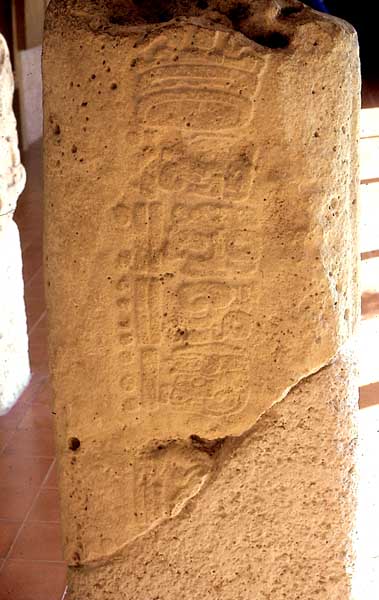 ***********************************************************
***********************************************************
Stela 31
The long inscription on the back of Stela 31, dedicated in 445 AD, is the single most important historical text from Tikal. The ruler Siyaj Chan K’awiil dedicated the monument on the period ending 9.0.10.0.0, and in its text presented a farreaching look at Tikal’s early political history, leading up to his own rule in the fifth century. Originally it may have stood on the terrace in front of 33
2nd and may have been broken some time during the late 6th or early 7th centuries when Tikal suffered defeats at the hands of other centres (Caracol,
Calakmul, and possibly Dos Pilas and Naranjo).
Originally it may have stood on the terrace in front of 33
2nd and may have been broken some time during the late 6th or early 7th centuries when Tikal suffered defeats at the hands of other centres (Caracol,
Calakmul, and possibly Dos Pilas and Naranjo).
Drawing of Stela 31


********************************************************************
Stela 4

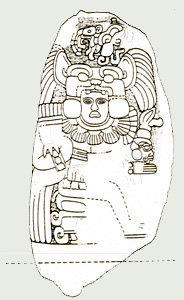 Stela 4 portrays
the tenth ruler in the Tikal succession, Curl Nose, who is named after his presumed name glyph. The style of Stela 4, and the regalia worn by the
sculptured portrait of Curl Nose, especially his shell necklace, recall Teotihuacan traditions and depícts Curl Nose seated and facing front. The
protector figure over Curl Nose's head is the Maya deity Bolon Tza'cab (God K), the patron of royalty. Curl Nose holds a spearthrower in his left arm.
The God K patron was eventually combined wíth the central-Mexican weapon, the spearthrower, to form the "manikin scepter," the symbol of lowland Maya
dynastic rulership.
Stela 4 portrays
the tenth ruler in the Tikal succession, Curl Nose, who is named after his presumed name glyph. The style of Stela 4, and the regalia worn by the
sculptured portrait of Curl Nose, especially his shell necklace, recall Teotihuacan traditions and depícts Curl Nose seated and facing front. The
protector figure over Curl Nose's head is the Maya deity Bolon Tza'cab (God K), the patron of royalty. Curl Nose holds a spearthrower in his left arm.
The God K patron was eventually combined wíth the central-Mexican weapon, the spearthrower, to form the "manikin scepter," the symbol of lowland Maya
dynastic rulership.
Many thought the characters depicted on the stelae were Gods. But as Maya Archaeology continued to make its pioneering advances in the middle of the humid rainforests of Guatemala, the contrary was revealed: the stelae contained nothing but information on the Rulers of The Maya World for more than 570 years.



Stela 31
The long inscription on the back of Stela 31, dedicated in 445 AD, is the single most important historical text from Tikal. The ruler Siyaj Chan K’awiil dedicated the monument on the period ending 9.0.10.0.0, and in its text presented a farreaching look at Tikal’s early political history, leading up to his own rule in the fifth century.
Stela 31 is the accession monument of Siyaj Chan K'awiil II, also bearing two portraits of his father, Yax Nuun Ayiin, as a youth dressed as a Teotihuacan warrior. He carries a spearthrower in one hand and bears a shield decorated with the face of Tlaloc, the Teotihuacan war god. In ancient times the sculpture was broken and the upper portion was moved to the summit of Temple 33 and ritually buried. Stela 31 has been described as the greatest Early Classic sculpture to survive at Tikal. A long hieroglyphic text is carved onto the back of the monument, the longest to survive from the Early Classic, which describes the arrival of Siyah K'ak' at El Peru and Tikal in January 378. It was also the first stela as Tikal to be carved on all four faces.

Drawing of Stela 31

Back view
It had been broken in two by burning and the upper half, seen here, placed within semi-demolished Str 5D 33 2nd(site) during construction of 33 1st(site). This is why it is less weathered than most Tikal stelae. The rear face retains traces of red paint.

Front view
This top piece we see here may have been placed within 33 1st by Jasaw Chan K'awiil, either after his accession to power in 682, or after his defeat of Calakmul in 695. Possibly this could be seen as a type of cache.

source
The ruler depicted here may have been named Siyaj Chan K'awiil according to a recent phonetic reading of his name glyphs (Simon Martin). These glyphs earlier yielded the name "Stormy Sky", based on their imagery. He was a particularly powerful and succesful ruler, possibly backed in some way by the might of Teotihuacan.
Siyaj Chan may have presided over a period of political supremacy for Tikal in the first half of the fifth century. This fragment of his stela may have been placed within the fabric of 33 1st as a kind of icon carrying power to accomplish the same thing in the 8th century.
********************************************************************
Stela 4

Stela 4 is dated to AD 396, during the reign of Yax Nuun Ayiin after the intrusion of Teotihuacan in the Maya area. The stela displays a mix of Maya and Teotihuacan qualities, and deities from both cultures. It has a portrait of the king with the Underworld Jaguar God under one arm and the Mexican Tlaloc under the other. His helmet is a simplified version of the Teotihuacan War Serpent. Unusually for Maya sculpture, but typically for Teotihuacan, Yax Nuun Ayiin is depicted with a frontal face, rather than in profile.


source
He(Yax Nuun Ayiin I) took the throne of Tikal on 13 September 379, soon after the death of previous king Chak Tok Ich'aak I, apparently killed by the Teotihuacano conquerors.
Yax Nuun Ayiin was a son of Spearthrower Owl, a lord of Teotihuacan (probably that city's king) in central Mexico. The installation of a Teotihuacano noble on the throne of Tikal marks a high point of Teotihuacan influence in the central Maya lowlands.
edit on 1/6/2013 by mcx1942 because: fix
edit on
1/6/2013 by mcx1942 because: fix
reply to post by murkraz
Tikal is very interesting, I have been there several times .... you can take the plane out of Cancun and make a day trip.
Tikal is very interesting, I have been there several times .... you can take the plane out of Cancun and make a day trip.
edit on 6-1-2013 by hal4511 because: addition
reply to post by mcx1942
Mcx
Great thread, fantastic pics and refs. Would have liked to have seen reconstructions with all the water in place to get an idea of the vista that greeted the ancient resident. Wonder if the Ball Courts could have been there if the place was flooded with water, maybe in the dry season.
As someone else rightly pointed out these structures are more like Ziggurats or Step Pyramids, both of which were never intended for the dead. Can't help wondering if the friezes, carvings and corpses aren't from a later date when the site had been abandoned temporarily because of a drought. It is not unheard of for inheritors of ancient sites to borrow the impressive achievements of their predecessors for their grave markers. that would make the body structures much older than the king's. Of course if there are refs in all those glyphys to these King's using the structures or building them the current dating would be correct. Imo those that built the water reservoirs were the creators, not the kings who used the Ziggurats as tombstones.
Will
Mcx
Great thread, fantastic pics and refs. Would have liked to have seen reconstructions with all the water in place to get an idea of the vista that greeted the ancient resident. Wonder if the Ball Courts could have been there if the place was flooded with water, maybe in the dry season.
As someone else rightly pointed out these structures are more like Ziggurats or Step Pyramids, both of which were never intended for the dead. Can't help wondering if the friezes, carvings and corpses aren't from a later date when the site had been abandoned temporarily because of a drought. It is not unheard of for inheritors of ancient sites to borrow the impressive achievements of their predecessors for their grave markers. that would make the body structures much older than the king's. Of course if there are refs in all those glyphys to these King's using the structures or building them the current dating would be correct. Imo those that built the water reservoirs were the creators, not the kings who used the Ziggurats as tombstones.
Will
reply to post by mcx1942
Very nice thread MCX, well done. I unfortunately never traveled to that city.
One suggestion; you are providing some links but not all of them its always best to cite those sources you are using when paraphrasing and presenting it as your words.
We look forward to more such threads.
Very nice thread MCX, well done. I unfortunately never traveled to that city.
One suggestion; you are providing some links but not all of them its always best to cite those sources you are using when paraphrasing and presenting it as your words.
We look forward to more such threads.
Amazing thread mate , spent a good 45 minutes reading it this morning !
will continue at lunch time ! makes for some good work break reading
great pics some of which I have never seen , I especially like the 3d renders.
The stelae are amazing I've played around with mayan writing before and tried to write a few words
but making sure the grammar is correct seems impossible without anyone to correct me !
maybe we can have a little back and forth and try it between ourselves?
Another thing that really puzzles me is that we are led to believe that the spannish killed off some of the maya , the rest disbanded , and left for the jungles , but for the most part the rest are still alive today , Why did they just leave the temples to rot in the jungles , why didnt they keep them and look after them if they were such holy sites ?
or were these sites much older and lost for much longer than we are led to believe !
will continue at lunch time ! makes for some good work break reading
great pics some of which I have never seen , I especially like the 3d renders.
The stelae are amazing I've played around with mayan writing before and tried to write a few words
but making sure the grammar is correct seems impossible without anyone to correct me !
maybe we can have a little back and forth and try it between ourselves?
Another thing that really puzzles me is that we are led to believe that the spannish killed off some of the maya , the rest disbanded , and left for the jungles , but for the most part the rest are still alive today , Why did they just leave the temples to rot in the jungles , why didnt they keep them and look after them if they were such holy sites ?
or were these sites much older and lost for much longer than we are led to believe !
Originally posted by sapien82
(snip)or were these sites much older and lost for much longer than we are led to believe !
Nope, because the Mayan use to put dates on things not to mention dating of the pottery associated with the ruins, dating volcanic glass used in tools, etc. Not all the Mayan cities were abandoned before the Spanish showed up. You might want to look at the history of the city of Tayasal which was taken in the year 1697
Fantastic thread op. I actually visited Tikal in 2005, when I was travelling through Central America. It was the most impressive of the Mayan ruins
that we visited. It was recommended to camp near by and wake up to the sunrise and the sound of the howler monkeys. For some reason we never made it
until the late morning. I think we kind of got hijacked in Belize on the way. Hijacked without really knowing it. Still we got there in the end.
As a Star Wars fan I was more excited about seeing the location of the rebel base than all the Mayan artefacts, but that's just me.
This thread is great to fill in the gaps of knowledge I ignored at the time. We were only there for one day and we felt a little uncomfortable about the travel/ hijack arrangement. We were never in danger, but were picked up in Mexico taken through Belize to Guatemala to accommodation I can best describe as a prison cell.
Thanks for you hard work op.
As a Star Wars fan I was more excited about seeing the location of the rebel base than all the Mayan artefacts, but that's just me.
This thread is great to fill in the gaps of knowledge I ignored at the time. We were only there for one day and we felt a little uncomfortable about the travel/ hijack arrangement. We were never in danger, but were picked up in Mexico taken through Belize to Guatemala to accommodation I can best describe as a prison cell.
Thanks for you hard work op.
edit on 7-1-2013 by woodwardjnr because: (no reason given)
Thank you to all that have checked out this thread.
I wanted to add some videos on Tikal as well.
The two videos below is footage from the University of Pennsylvania Museum of the Tikal Project. The ones I have watched do not have audio so put some cool 'jungle'y' music on while watching for mood music.Link to Project Tikal Playlist(42 videos): www.youtube.com...
The old time footage videos are my personal favorite.
Vacation style video
I wanted to add some videos on Tikal as well.
The two videos below is footage from the University of Pennsylvania Museum of the Tikal Project. The ones I have watched do not have audio so put some cool 'jungle'y' music on while watching for mood music.Link to Project Tikal Playlist(42 videos): www.youtube.com...
The old time footage videos are my personal favorite.
Vacation style video
edit on 1/7/2013 by mcx1942 because: fix
edit on 1/7/2013 by mcx1942 because: fix
Originally posted by woodwardjnr
As a Star Wars fan I was more excited about seeing the location of the rebel base than all the Mayan artefacts, but that's just me.
From this picture in the thread I learned that the Star Wars scene was taken from Temple IV

The scene from Star Wars – A New Hope – Episode IV
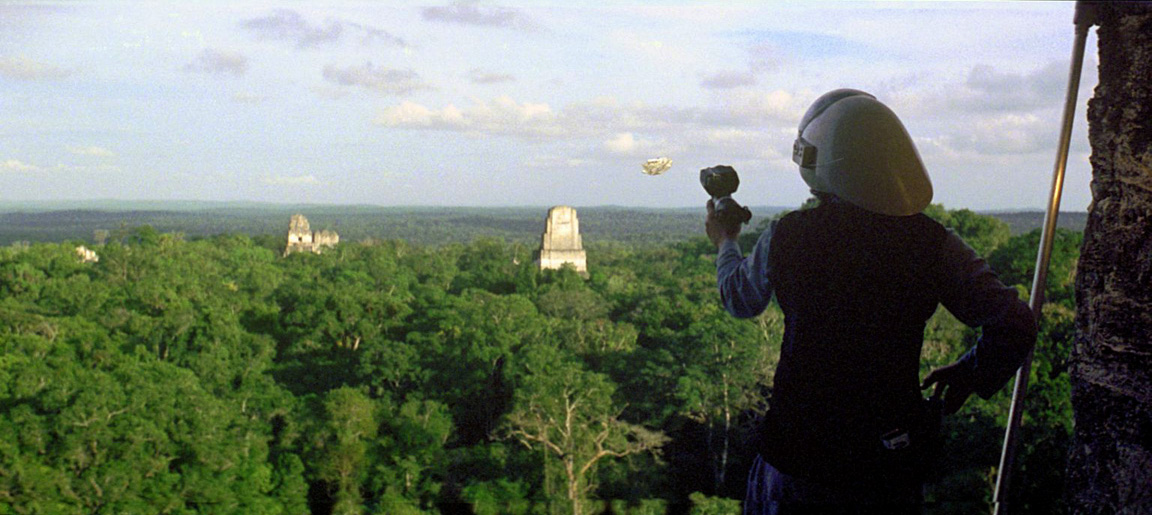
Temple IV and the Episode IV numbering sequence can’t be a coincidence.
Great Thread! I enjoyed the guided tour without having to go there. I can't wait for more details.
reply to post by mcx1942
Since you are our resident expert of Tikal I was wondering if you know every inch of that site, above and below ground. You mentioned the fact that this city was influenced by the Teotihuacan culture because they made carvings depicting Tlaloc. Have you ever heard of a subterranean chamber being found at Tikal that had Tollan style artwork?
By the way, I loved seeing the old film footage. Thanks for providing the links.
Since you are our resident expert of Tikal I was wondering if you know every inch of that site, above and below ground. You mentioned the fact that this city was influenced by the Teotihuacan culture because they made carvings depicting Tlaloc. Have you ever heard of a subterranean chamber being found at Tikal that had Tollan style artwork?
By the way, I loved seeing the old film footage. Thanks for providing the links.
new topics
-
Intro once again
Introductions: 18 minutes ago -
University student disciplined after saying veganism is wrong and gender fluidity is stupid
Education and Media: 1 hours ago -
Geddy Lee in Conversation with Alex Lifeson - My Effin’ Life
People: 2 hours ago -
God lived as a Devil Dog.
Short Stories: 2 hours ago -
Police clash with St George’s Day protesters at central London rally
Social Issues and Civil Unrest: 4 hours ago -
TLDR post about ATS and why I love it and hope we all stay together somewhere
General Chit Chat: 5 hours ago -
Hate makes for strange bedfellows
US Political Madness: 7 hours ago -
Who guards the guards
US Political Madness: 10 hours ago -
Has Tesla manipulated data logs to cover up auto pilot crash?
Automotive Discussion: 11 hours ago
top topics
-
Hate makes for strange bedfellows
US Political Madness: 7 hours ago, 15 flags -
Who guards the guards
US Political Madness: 10 hours ago, 13 flags -
whistleblower Captain Bill Uhouse on the Kingman UFO recovery
Aliens and UFOs: 16 hours ago, 11 flags -
Police clash with St George’s Day protesters at central London rally
Social Issues and Civil Unrest: 4 hours ago, 7 flags -
TLDR post about ATS and why I love it and hope we all stay together somewhere
General Chit Chat: 5 hours ago, 5 flags -
University student disciplined after saying veganism is wrong and gender fluidity is stupid
Education and Media: 1 hours ago, 3 flags -
Has Tesla manipulated data logs to cover up auto pilot crash?
Automotive Discussion: 11 hours ago, 2 flags -
God lived as a Devil Dog.
Short Stories: 2 hours ago, 2 flags -
Geddy Lee in Conversation with Alex Lifeson - My Effin’ Life
People: 2 hours ago, 2 flags -
Intro once again
Introductions: 18 minutes ago, 1 flags
active topics
-
My wife just had a very powerful prophetic dream - massive war in Israel...
The Gray Area • 13 • : BukkaWukka -
Terrifying Encounters With The Black Eyed Kids
Paranormal Studies • 59 • : Consvoli -
Mandela Effect - It Happened to Me!
The Gray Area • 114 • : ArMaP -
Silent Moments --In Memory of Beloved Member TDDA
Short Stories • 69 • : Naftalin -
Hate makes for strange bedfellows
US Political Madness • 32 • : theatreboy -
Police clash with St George’s Day protesters at central London rally
Social Issues and Civil Unrest • 36 • : FlyersFan -
"We're All Hamas" Heard at Columbia University Protests
Social Issues and Civil Unrest • 249 • : marg6043 -
Europe declares war on Russia?
World War Three • 66 • : Consvoli -
Candidate TRUMP Now Has Crazy Judge JUAN MERCHAN After Him - The Stormy Daniels Hush-Money Case.
Political Conspiracies • 732 • : matafuchs -
Spectrophilia - Women Who Have Had Affairs With Ghosts Say Spooks Are Better Lovers Than Real Men
Paranormal Studies • 28 • : FlyersFan
